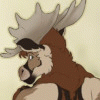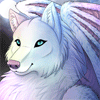
*dance*
Category All / All
Species Vulpine (Other)
Size 2550 x 3300px
File Size 8.57 MB
This wuff is no artist, but did study music for quite a few years, many (MANY!) years ago. Lets see if some of the tips from this wuff's old instructors might be helpful for you.
Vrghr always found that drawing the vertical "drop" first was the easiest way to start the G-Clef.
- The Vertical line can be perfectly upright (more common with computer/type-face than hand-drawn), or may recline slightly. It should begin in the space just above the top line of the staff (the "F"), and extend approximately equidistant below the bottom line with a little "hook" at the end that curls back up toward, but not touching, the bottom line of the staff (the "E" line)
- Draw a stylized cursive "G" for the rest of the symbol.
-- The upper bow should surround the upper "F" line of the music staff
-- The curve should cross the vertical member of the cleff directly over the next line down (the "D" line)
-- The bottom of the larger curve should just rest on the lowest line of the staff (the "E" line)
-- The center of the spiraling curve should cross the second line from the bottom (the "G" line of the staff) EXACTLY 3 times! This signifies that the "G-Clef" marks the "G" of the staff and defines the range of notes for that staff (E, G, B, D, F for the lines). The "tail" of that spiral can curl back toward the "G" line, but must not touch or cross it a 4th time
The G-Clef originated with hand-written calligraphy, so a "quill" or "calligraphic" brush exactly vertical for the initial "drop" and at about 45 degrees slant for the rest, should give a good approximation of the thick and thin elements of the line itself.
Sure hope this is at least a bit of help!
VRGHR
Vrghr always found that drawing the vertical "drop" first was the easiest way to start the G-Clef.
- The Vertical line can be perfectly upright (more common with computer/type-face than hand-drawn), or may recline slightly. It should begin in the space just above the top line of the staff (the "F"), and extend approximately equidistant below the bottom line with a little "hook" at the end that curls back up toward, but not touching, the bottom line of the staff (the "E" line)
- Draw a stylized cursive "G" for the rest of the symbol.
-- The upper bow should surround the upper "F" line of the music staff
-- The curve should cross the vertical member of the cleff directly over the next line down (the "D" line)
-- The bottom of the larger curve should just rest on the lowest line of the staff (the "E" line)
-- The center of the spiraling curve should cross the second line from the bottom (the "G" line of the staff) EXACTLY 3 times! This signifies that the "G-Clef" marks the "G" of the staff and defines the range of notes for that staff (E, G, B, D, F for the lines). The "tail" of that spiral can curl back toward the "G" line, but must not touch or cross it a 4th time
The G-Clef originated with hand-written calligraphy, so a "quill" or "calligraphic" brush exactly vertical for the initial "drop" and at about 45 degrees slant for the rest, should give a good approximation of the thick and thin elements of the line itself.
Sure hope this is at least a bit of help!
VRGHR

 FA+
FA+




























Comments